Together with NABU, REWE has long been committed to climate protection. A moor is now being renaturalised through the NABU climate fund. A visit on site.
The large-scale moorland restoration is the first project of the NABU Climate Fund, which REWE and NABU launched in spring 2022. REWE will invest a total of at least 25 million euros in the climate fund over five years. But how can you actually imagine such a renaturalisation? What does it look like on the ground now? How are things progressing? We wanted to find out and travelled to the Ahlen-Falkenberger Moor near Cuxhaven. We went there to see for ourselves - and spoke to NABU moor expert Dr Frank Woesthoff and Julia Krooß, Portfolio Manager of the NABU Climate Fund.
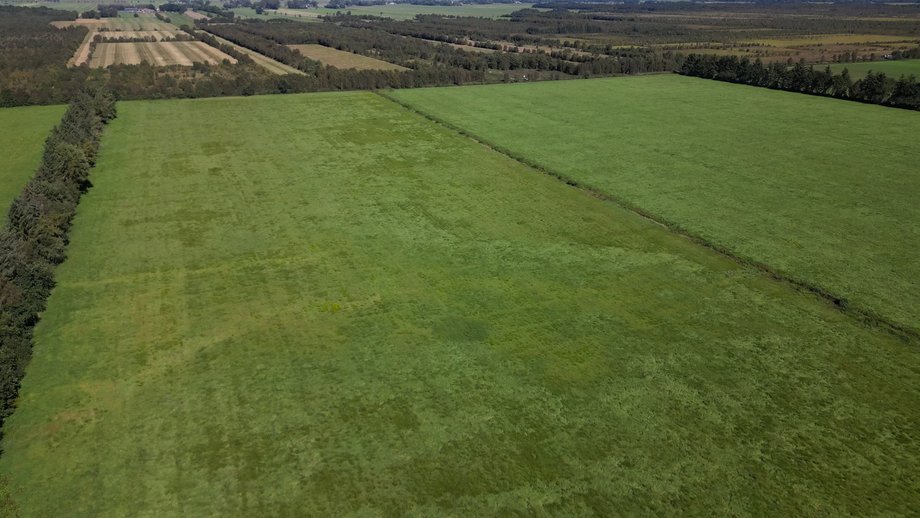 A bird's eye view of the future moorland landscape.
A bird's eye view of the future moorland landscape.
The view sweeps across green meadows, criss-crossed by a few small ditches and lined with rows of trees at the edges: Parts of the Ahlen-Falkenberger Moor to the south-east of Cuxhaven appear like a green, rural idyll. But it is actually a destroyed landscape. Until the 1960s, the vast areas, which have sunk by around two metres, were an intact moor. If REWE and the German Nature and Biodiversity Conservation Union (NABU) have their way, it should be restored. And preferably as quickly as possible.
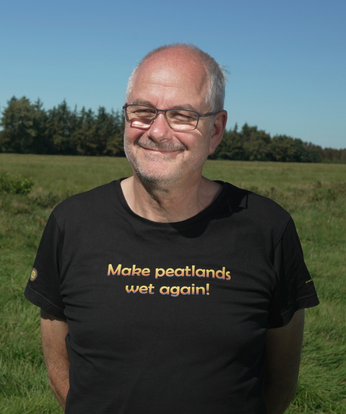 NABU moor expert Dr Frank Woesthoff
Frank Woesthoff, NABU bog expert, stands in the centre of the vast area, which stretches over 200 hectares. "It is the largest peatland conservation project on agricultural land in Europe," he says. "And the financial power of the NABU climate fund is absolutely essential for this." NABU first had to acquire the land before it could be restored to its original state. In good weather, you can walk through the "moor" with dry feet. Over the decades, ditches and drainage systems have ensured that the original moor first dried out and then shrank.
NABU moor expert Dr Frank Woesthoff
Frank Woesthoff, NABU bog expert, stands in the centre of the vast area, which stretches over 200 hectares. "It is the largest peatland conservation project on agricultural land in Europe," he says. "And the financial power of the NABU climate fund is absolutely essential for this." NABU first had to acquire the land before it could be restored to its original state. In good weather, you can walk through the "moor" with dry feet. Over the decades, ditches and drainage systems have ensured that the original moor first dried out and then shrank.
„REWE really is a pioneer here, because never before has anyone from the private sector invested so much money in the protection of moors.“ Dr Frank Woesthoff, Head of NABU Climate Fund
But why are peatlands so important for climate protection? Quite simply, they store more carbon in their peat than any other terrestrial ecosystem - making peatlands twice as effective as forests. In a peatland, dead plants do not decompose completely due to the wet conditions. The carbon they contain thus remains permanently stored. This creates peat - and a large carbon store. If peatlands are destroyed, the carbon stored in them is released again as climate-damaging CO2.
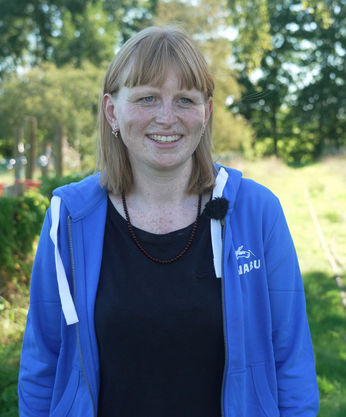 Julia Krooß, Portfolio Manager of the NABU Climate Fund
That is why the top priority is to keep the remaining carbon in the soil permanently. "If CO2 were black, then we would be standing here in a black fog," explains Julia Krooß, Portfolio Manager of the NABU Climate Fund. Around 6,800 tonnes of CO2 escape from the area every year. According to boreholes, the areas still contain around 800,000 tonnes of CO2, which are also to be kept under lock and key. To this end, the first work will now begin in the autumn by removing the top 20 centimetres of the meadow area.
Julia Krooß, Portfolio Manager of the NABU Climate Fund
That is why the top priority is to keep the remaining carbon in the soil permanently. "If CO2 were black, then we would be standing here in a black fog," explains Julia Krooß, Portfolio Manager of the NABU Climate Fund. Around 6,800 tonnes of CO2 escape from the area every year. According to boreholes, the areas still contain around 800,000 tonnes of CO2, which are also to be kept under lock and key. To this end, the first work will now begin in the autumn by removing the top 20 centimetres of the meadow area.
"There's still a lot of fertiliser in it. That doesn't suit the plants in the moor," explains Frank Woesthoff. This is because they need wet, acidic and nutrient-poor soil. The spoil from the top layer is used to build small embankments and fill in the ditches. The underground clay pipes that transport the water to the ditches are also gradually being destroyed. These measures are intended to raise the water level in the area again. The future moor will only be irrigated by rainwater, of which many millions of cubic metres are needed. This is why the renaturalisation of moors requires patience. The peat layer only grows one millimetre per year. But there is already a little peat today: Julia Krooß digs a little in the mounds that the mole has thrown up all over the area. You can grab the peat that is still in the ground with your bare hands.
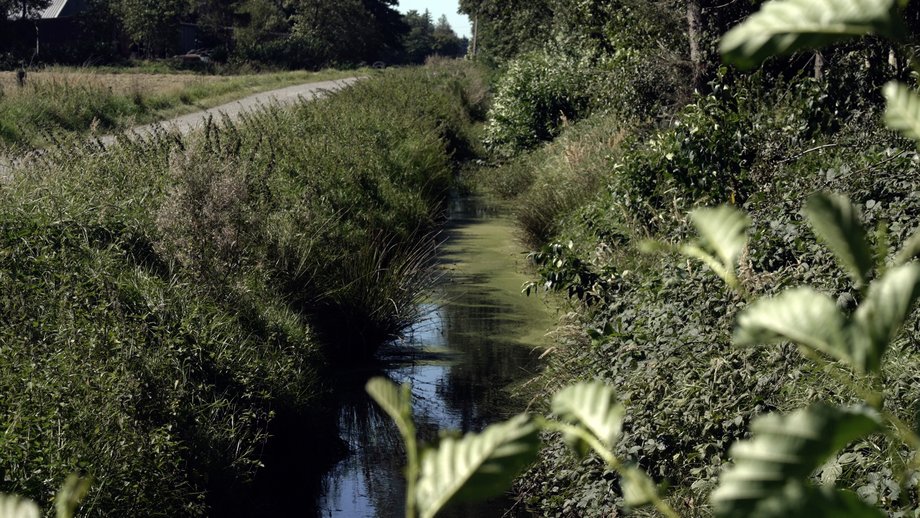 Drainage ditch at the Ahlen-Falkenberger Moor near Cuxhaven.
Frank Woesthoff estimates that it will take at least three to four years for this to become more widespread again. Then there will be less or no dense grassland as there is now, but fauna that belongs to the moor: small moss plants, sedges, bell heather, small orchid species that are important for wild bees, for example. This is also an important effect of the renaturalisation of moors, which not only protects the climate but also provides a home for many animal species.
Drainage ditch at the Ahlen-Falkenberger Moor near Cuxhaven.
Frank Woesthoff estimates that it will take at least three to four years for this to become more widespread again. Then there will be less or no dense grassland as there is now, but fauna that belongs to the moor: small moss plants, sedges, bell heather, small orchid species that are important for wild bees, for example. This is also an important effect of the renaturalisation of moors, which not only protects the climate but also provides a home for many animal species.
"As a major food retailer, we are aware of our responsibility for climate protection. That is why it is very important to us to voluntarily support climate protection projects in Germany and Europe in addition to reduction measures. The NABU climate fund on the products of our own brands REWE Bio and REWE Beste Wahl also makes climate protection tangible for our customers," says Nicola Tanaskovic, Head of Corporate Responsibility, about the joint commitment with our long-standing partner NABU.
Location: Lower Saxony, south-east of Cuxhaven
Area: approx. 200 hectares
CO2 in the soil: 800,000 tonnes
Special feature: Largest peatland restoration area in Europe on an area previously used for agriculture
Duration: Start in autumn 2023, processing of the first section until approx. 2026/2027. Duration of the entire project until 2043 at the latest.







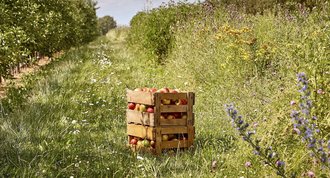





Both German and English comments appear here.
GREAT!!!